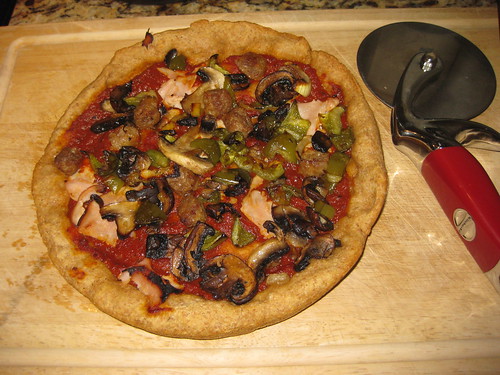
[ Cookbook Home | Ingredients Note | Beverages | Soups | Breads | Sweets | Meals ]
I learned to make bread making pizza crust, at a very tender age. My family bought the Appian Way Pizza kit, available on Amazon now, which my sisters and I made when my parents were out on Wednesday nights. The process of making pizza is so ingrained by that childhood ritual that it isn't easy for me to describe. Switching to real bread for the crust was a huge win, as was using my own sauce, but it took a few tries to get it right. It is also a time-consuming process (waiting for the rises), particularly if you haven't made a yeast bread before. Plan to blow a day on this the first time out and don't expect to eat the results.
The crust is adapted from James Beard's Pizza Caccia Nanza in Beard on Bread, who tells a story of getting it from someone else.
Combine in a mixing bowl:
2 1/2 Cups Flour
1/2 Tsp Salt
2 Tsp Dry Yeast
1 Cup Warm Water
Mix, ideally in a stand mixer on low. Knead for a few minutes on a floured board. Roll about 1 Tbsp Olive Oil around a large bowl. Put the dough in the bowl and cover it with a clean cloth. Set it somewhere warm until it doubles in size, 45 minutes to a little over an hour.
While you are waiting, prepare the Sauce and Toppings.
Mostly adapted from my Vegetarian Marinara Sauce.
Blend or food process:
1 Can Tomatoes in Puree
1 Clove Garlic
1 Tbsp Onion
You can use onion and garlic powder if you prefer, or skip entirely. Pour the tomato sauce into a warm frying pan (if it isn't non-stick, you might want to oil it first).
If you use the pan to saute the toppings before you make the sauce, it will supply a little additional flavor to the sauce.
Add to taste:
Fresh Ground Black Pepper
Dash Worcestershire Sauce
Dash Hot Sauce
Oregano
Thyme
Basil
I don't use cheese, but you could grate some mozzarella, or make squares of cheddar, or whatever you like. I usually slice and saute some mushrooms, onion, garlic. I don't generally saute chopped bell peppers. I like preserved artichoke hearts (read labels carefully for sodium content!). If I'm having meat, it's usually pepperoni or salami, sliced.
Now that the dough has doubled, punch it down, then roll it out to the shape (or shapes) you want.
Preheat oven to 400 degrees.
If you've got your own system for creating a pizza crust, go you. You can use a rolling pin, but you risk shoving all the air bubbles out of your bread and it not rising (if you are going for a thin, bistro-style crust, this may be what you want). Generally, I grease the pan I'm using, plop the dough ball down and then use the heel of my palm in a somewhat circular motion to flatten it out in the shape I want. If the dough resists being stretched, you can pick it up and shake it into a larger sheet that's easier to deal with. I'd skip tossing it in the air. Unlike professional pizza crust makers (often substance abusing high school dropouts or grads that can't be bothered to go to college, or just haven't gotten there yet), you are going to eat what you are making -- not sell it to someone you hold in contempt.
Let the dough sit at least another 15 minutes. Cook it for 5 minutes before putting toppings on, or it tends to be a bit soggy.
Pour the sauce over the crust and arrange the toppings. Cook the pizza for about 20 minutes, or until crust browns, if without cheese, or longer, until the cheese melts and browns.
[ Cookbook Home | Ingredients Note | Beverages | Soups | Breads | Sweets | Meals ]
Copyright Rebecca Allen, 2002.
Created January 21, 2002 Updated 25 August 2013